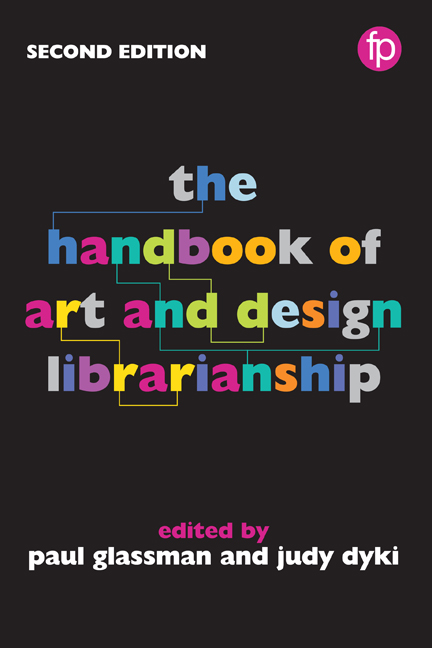Book contents
- Frontmatter
- Contents
- List of figures and tables
- Notes on contributors
- Foreword
- Preface
- Part I Roles and responsibilities
- Part II Materials and collection management
- 6 Visual resources: from analogue to digital and beyond
- 7 Developing digital collections
- 8 Inspirational encounters: the management and use of archives and special collections in the art and design library
- 9 What is special about special collections?
- 10 Artists’ books in the art and design library
- 11 Art documentation: exhibition catalogues and beyond
- 12 Tactile libraries: material collections in art, architecture and design
- 13 Seeing the bigger picture: archival description of visual information
- Part III Teaching and learning
- Part IV Knowledge creation
- Part V The physical environment
- Part VI Promotion and sustainability
- Appendix Library profiles
- Index
11 - Art documentation: exhibition catalogues and beyond
from Part II - Materials and collection management
Published online by Cambridge University Press: 08 June 2018
- Frontmatter
- Contents
- List of figures and tables
- Notes on contributors
- Foreword
- Preface
- Part I Roles and responsibilities
- Part II Materials and collection management
- 6 Visual resources: from analogue to digital and beyond
- 7 Developing digital collections
- 8 Inspirational encounters: the management and use of archives and special collections in the art and design library
- 9 What is special about special collections?
- 10 Artists’ books in the art and design library
- 11 Art documentation: exhibition catalogues and beyond
- 12 Tactile libraries: material collections in art, architecture and design
- 13 Seeing the bigger picture: archival description of visual information
- Part III Teaching and learning
- Part IV Knowledge creation
- Part V The physical environment
- Part VI Promotion and sustainability
- Appendix Library profiles
- Index
Summary
Introduction
The literature of the history, theory and practice of art and design has been in continual evolution since Leon Battista Alberti wrote De Pictura in 1435 (and Della Pittura in 1436), almost contemporaneously with the invention of the printing press in around 1440. A growing range of publications establishing new ways of documenting the work of artists and designers would follow this theoretical treatise: biographies, catalogues and journals. In recent years influenced by new digital tools and methods, this literature is still evolving, and it is central to the resources and practice of art and design librarianship.
Art catalogues are arguably the main form of art documentation today, and a cornerstone of the bibliography of the subject. Widely published by museums, public and commercial galleries, academic and commercial publishers and others – still primarily in print format – their history can be traced to the first art collection catalogues published in the 17th century and to group and solo exhibition catalogues that appear in the 18th century.
This chapter explores the present and potential future of the art catalogue and related formats, their role in the documentation of art, and their management and use in art and design libraries. Exhibition catalogues, collection catalogues, catalogues raisonnés, sales catalogues and art ephemera are primary and secondary source materials, documenting artworks and their history, particularly their public presentation in exhibitions and museums. Exhibition catalogues, alongside special formats like recurrent exhibition documentation (e.g. biennials, triennials), auction and sales catalogues, scholarly collec - tion catalogues and catalogues raisonnés, present a number of common characteristics, and their management in library collections often requires specialist knowledge, as they can be challenging to acquire and require expert cataloguing. Art ephemera (e.g. invitations, posters, lists of works, press releases) are another important if underrated resource collected by libraries as a complementary source of information on exhibitions and artworks. These materials and their management, from collection development to facilitating access and use, are the focus of this chapter.
The exhibition catalogue
Originally simply lists of artists and titles of works with dates, exhibition catalogues have added considerable content over time: images (from drawings to photographs), descriptions and analysis of the works, critical essays, chronologies, biographies of the artists, bibliographies and indexes.
- Type
- Chapter
- Information
- The Handbook of Art and Design Librarianship , pp. 109 - 118Publisher: FacetPrint publication year: 2017
- 2
- Cited by



